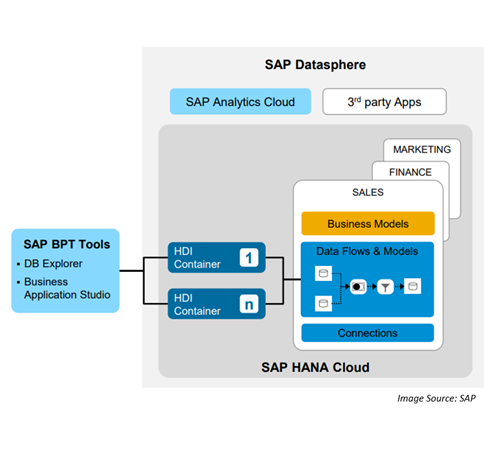Mastering SAP HANA Cloud Development with HDI Containers and SAP Datasphere
What Are HDI Containers?
Before we get into the nitty-gritty, let’s demystify HDI containers. HDI stands for SAP HANA Deployment Infrastructure, a key service that helps you deploy database development artifacts into containers. Think of them as specialized storage units for your database artifacts. These artifacts include:
The beauty of HDI is that it maintains a consistent set of design-time artifacts that describe the target state of SAP HANA database features, streamlining both development and deployment processes.
Integrating HDI Containers with SAP Datasphere
SAP Datasphere allows the assignment of built HDI containers to its spaces, providing immediate bi-directional access between HDI containers and Datasphere spaces without requiring data movement. This integration enhances flexibility and efficiency in data management and modeling processes.
Before we get into the nitty-gritty, let’s demystify HDI containers. HDI stands for SAP HANA Deployment Infrastructure, a key service that helps you deploy database development artifacts into containers. Think of them as specialized storage units for your database artifacts. These artifacts include:
- Tables
- Views
- Procedures
- Advanced Artifacts: Calculation views, flowgraphs, replication tasks
The beauty of HDI is that it maintains a consistent set of design-time artifacts that describe the target state of SAP HANA database features, streamlining both development and deployment processes.
Integrating HDI Containers with SAP Datasphere
SAP Datasphere allows the assignment of built HDI containers to its spaces, providing immediate bi-directional access between HDI containers and Datasphere spaces without requiring data movement. This integration enhances flexibility and efficiency in data management and modeling processes.

- Deploy HDI Containers: Use SAP Business Application Studio (BAS) to create and deploy HDI containers in the underlying SAP HANA Cloud database.
- Assign Containers to Spaces: In SAP Datasphere, enable HDI Container access and assign the deployed HDI containers to specific spaces to access their objects and content immediately.
- Refine Models in SAP Datasphere: Use the Data Builder in SAP Datasphere to create and refine models within your HDI containers. You can combine these models with others in Datasphere, ensuring seamless integration.
- Refine Models in HDI Containers: Allow models and datasets from SAP Datasphere’s space schema to be utilized within your HDI containers, enabling a two-way interaction.
Business Use Cases for HDI Containers within SAP Datasphere
HDI container-based developments support a wide range of scenarios, including:
- Migration from HANA Enterprise Data Mart to SAP Datasphere: Organizations can leverage multi-model analytics capabilities while migrating from HANA Enterprise Data Mart to SAP Datasphere. This transition allows for advanced data analytics and modeling within a modern, integrated environment.
- Migration from SAP BW to SAP Datasphere: By utilizing native HANA developments, companies migrating from SAP BW to SAP Datasphere can maintain their existing data processes and enhance their data warehousing capabilities with the advanced features of SAP HANA Cloud.
- External OData Consumption or Web API Exposure: SAP Datasphere enables the publication of space objects as external OData services or Web APIs. This capability facilitates seamless data sharing and integration with external applications and services.
- Complex On-Prem Use Cases: Handle complex on-prem scenarios with limitations in adopting Datasphere.
- Complex DB Procedures for Actionable Functionality: Develop and manage complex database procedures to implement actionable functionalities.
- HANA Sidecar Phased Retirement: Gradually retire HANA sidecar systems by integrating with SAP Datasphere.
- Migrate PAL and APL Use Cases: Migrate Predictive Analysis Library (PAL) and Automated Predictive Library (APL) use cases from on-premises to HANA Cloud.
- Leverage Machine Learning Capabilities: Utilize embedded machine learning and advanced analytics within SAP Datasphere without data extraction.
- Data Science Enrichment: Use existing Python or R environments to trigger calculations in SAP Datasphere, train ML models, and store prediction results in HDI container tables.
The integration of HDI containers within SAP Datasphere offers several significant advantages:
- Immediate Access: Objects and content of HDI containers are instantly accessible within SAP Datasphere spaces without the need for data movement.
- Seamless Workflow: Users can harness SAP HANA Cloud’s advanced features while enjoying a user-friendly environment in SAP Datasphere.
- Advanced Data Modelling: HDI containers support complex developments and provide advanced functionalities that complement the user-oriented features of SAP Datasphere.
- Git Versioning: HDI introduces the usage of versioning tools like Git, which helps in conflict resolution and allows many developers to develop in parallel without interference. This supports modern development styles and accelerates development cycles on the database.
- Life Cycle Management: Supports automated CI/CD pipelines for efficient life cycle management.
- Higher Parallelism: HDI supports higher parallelism with no singleton deployment, allowing for more efficient and faster deployment processes.
- Debugging and Performance Optimization: HDI provides robust debugging and performance optimization capabilities, leveraging SAP HANA optimization techniques such as pruning and parallelization to ensure high performance.
Combining the development strengths of HDI containers with the user-friendly features of SAP Datasphere offers the best of both worlds. This hybrid approach supports advanced and complex data developments while ensuring ease of use and maintainability. For large projects with multiple developers, the choice between HANA and Datasphere will depend on specific requirements, such as the need for version control and Git integration.
By leveraging HDI containers in SAP Datasphere, organizations can achieve seamless data management and complex data modeling capabilities, ultimately enhancing their data warehousing solutions.
For more detailed guidance on implementing HDI container-based developments in SAP Datasphere, refer to the comprehensive resources available on the SAP Community.
Feel free to contact us with questions or to schedule a demonstration of this capability.

Please complete the form to access the whitepaper:
